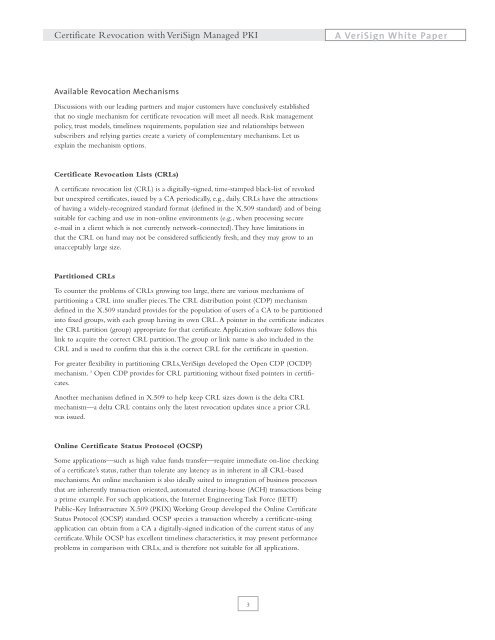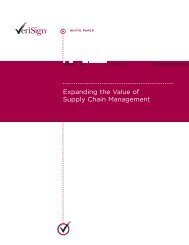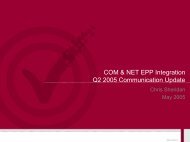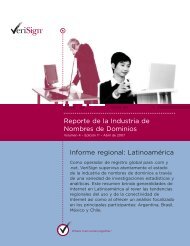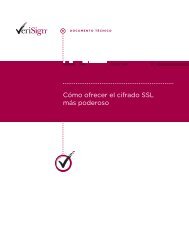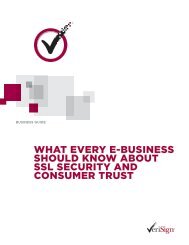Certificate Revocation with VeriSign Managed PKI - White Paper
Certificate Revocation with VeriSign Managed PKI - White Paper
Certificate Revocation with VeriSign Managed PKI - White Paper
Create successful ePaper yourself
Turn your PDF publications into a flip-book with our unique Google optimized e-Paper software.
<strong>Certificate</strong> <strong>Revocation</strong> <strong>with</strong> <strong>VeriSign</strong> <strong>Managed</strong> <strong>PKI</strong>A <strong>VeriSign</strong> <strong>White</strong> <strong>Paper</strong>Available <strong>Revocation</strong> MechanismsDiscussions <strong>with</strong> our leading partners and major customers have conclusively establishedthat no single mechanism for certificate revocation will meet all needs. Risk managementpolicy, trust models, timeliness requirements, population size and relationships betweensubscribers and relying parties create a variety of complementary mechanisms. Let usexplain the mechanism options.<strong>Certificate</strong> <strong>Revocation</strong> Lists (CRLs)A certificate revocation list (CRL) is a digitally-signed, time-stamped black-list of revokedbut unexpired certificates, issued by a CA periodically, e.g., daily. CRLs have the attractionsof having a widely-recognized standard format (defined in the X.509 standard) and of beingsuitable for caching and use in non-online environments (e.g., when processing securee-mail in a client which is not currently network-connected).They have limitations inthat the CRL on hand may not be considered sufficiently fresh, and they may grow to anunacceptably large size.Partitioned CRLsTo counter the problems of CRLs growing too large, there are various mechanisms ofpartitioning a CRL into smaller pieces.The CRL distribution point (CDP) mechanismdefined in the X.509 standard provides for the population of users of a CA to be partitionedinto fixed groups, <strong>with</strong> each group having its own CRL. A pointer in the certificate indicatesthe CRL partition (group) appropriate for that certificate. Application software follows thislink to acquire the correct CRL partition.The group or link name is also included in theCRL and is used to confirm that this is the correct CRL for the certificate in question.For greater flexibility in partitioning CRLs,<strong>VeriSign</strong> developed the Open CDP (OCDP)mechanism. 3 Open CDP provides for CRL partitioning <strong>with</strong>out fixed pointers in certificates.Another mechanism defined in X.509 to help keep CRL sizes down is the delta CRLmechanism—a delta CRL contains only the latest revocation updates since a prior CRLwas issued.Online <strong>Certificate</strong> Status Protocol (OCSP)Some applications—such as high value funds transfer—require immediate on-line checkingof a certificate’s status, rather than tolerate any latency as in inherent in all CRL-basedmechanisms. An online mechanism is also ideally suited to integration of business processesthat are inherently transaction oriented, automated clearing-house (ACH) transactions beinga prime example. For such applications, the Internet Engineering Task Force (IETF)Public-Key Infrastructure X.509 (<strong>PKI</strong>X) Working Group developed the Online <strong>Certificate</strong>Status Protocol (OCSP) standard. OCSP species a transaction whereby a certificate-usingapplication can obtain from a CA a digitally-signed indication of the current status of anycertificate.While OCSP has excellent timeliness characteristics, it may present performanceproblems in comparison <strong>with</strong> CRLs, and is therefore not suitable for all applications.3


